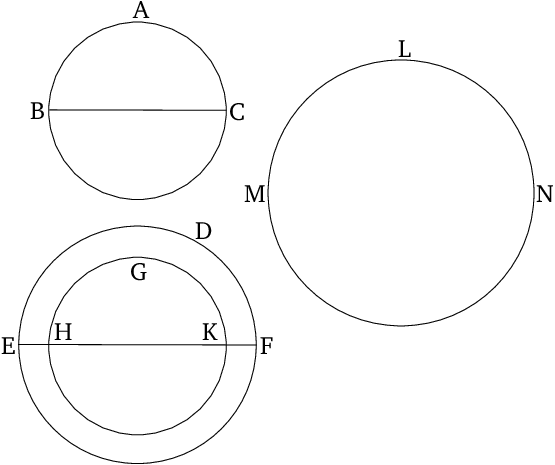Proof: By Euclid
(related to Proposition: Prop. 12.18: Volumes of Spheres are in Triplicate Ratio of Diameters)
- Let the spheres $ABC$ and $DEF$ have been conceived, and (let) their diameters (be) $BC$ and $EF$ (respectively).
- I say that sphere $ABC$ has to sphere $DEF$ the cubed ratio that $BC$ (has) to $EF$.

- For if sphere $ABC$ does not have to sphere $DEF$ the cubed ratio that $BC$ (has) to $EF$ then sphere $ABC$ will have to some (sphere) either less than, or greater than, sphere $DEF$ the cubed ratio that $BC$ (has) to $EF$.
- Let it, first of all, have (such a ratio) to a lesser (sphere), $GHK$.
- And let $DEF$ have been conceived about the same center as $GHK$.
- And let a polyhedral solid have been inscribed in the greater sphere $DEF$, not touching the lesser sphere $GHK$ on its surface [Prop. 12.17].
- And let a polyhedral solid, similar to the polyhedral solid in sphere $DEF$, have also been inscribed in sphere $ABC$.
- Thus, the polyhedral solid in sphere $ABC$ has to the polyhedral solid in sphere $DEF$ the cubed ratio that $BC$ (has) to $EF$ [Prop. 12.17 corr.] .
- And sphere $ABC$ also has to sphere $GHK$ the cubed ratio that $BC$ (has) to $EF$.
- Thus, as sphere $ABC$ is to sphere $GHK$, so the polyhedral solid in sphere $ABC$ (is) to the polyhedral solid is sphere $DEF$.
- Thus, alternately, as sphere $ABC$ (is) to the polygon within it, so sphere $GHK$ (is) to the polyhedral solid within sphere $DEF$ [Prop. 5.16].
- And sphere $ABC$ (is) greater than the polyhedron within it.
- Thus, sphere $GHK$ (is) also greater than the polyhedron within sphere $DEF$ [Prop. 5.14].
- But, (it is) also less.
- For it is encompassed by it.
- Thus, sphere $ABC$ does not have to (a sphere) less than sphere $DEF$ the cubed ratio that diameter $BC$ (has) to $EF$.
- So, similarly, we can show that sphere $DEF$ does not have to (a sphere) less than sphere $ABC$ the cubed ratio that $EF$ (has) to $BC$ either.
- So, I say that sphere $ABC$ does not have to some (sphere) greater than sphere $DEF$ the cubed ratio that $BC$ (has) to $EF$ either.
- For, if possible, let it have (the cubed ratio) to a greater (sphere), $LMN$.
- Thus, inversely, sphere $LMN$ (has) to sphere $ABC$ the cubed ratio that diameter $EF$ (has) to diameter $BC$ [Prop. 5.7 corr.] .
- And as sphere $LMN$ (is) to sphere $ABC$, so sphere $DEF$ (is) to some (sphere) less than sphere $ABC$, inasmuch as $LMN$ is greater than $DEF$, as was shown before [Prop. 12.2 lem.] .
- And, thus, sphere $DEF$ has to some (sphere) less than sphere $ABC$ the cubed ratio that $EF$ (has) to $BC$.
- The very thing was shown (to be) impossible.
- Thus, sphere $ABC$ does not have to some (sphere) greater than sphere $DEF$ the cubed ratio that $BC$ (has) to $EF$.
- And it was shown that neither (does it have such a ratio) to a lesser (sphere).
- Thus, sphere $ABC$ has to sphere $DEF$ the cubed ratio that $BC$ (has) to $EF$.
- (Which is) the very thing it was required to show.
∎
Thank you to the contributors under CC BY-SA 4.0! 

- Github:
-

- non-Github:
- @Fitzpatrick
References
Adapted from (subject to copyright, with kind permission)
- Fitzpatrick, Richard: Euclid's "Elements of Geometry"
